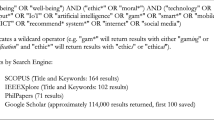Abstract
Awareness systems have attracted significant research interest for their potential to support interpersonal relationships. Investigations of awareness systems for the domestic environment have suggested that such systems can help individuals stay in touch with dear friends or family and provide affective benefits to their users. Our research provides empirical evidence to refine and substantiate such suggestions. We report our experience with designing and evaluating the ASTRA awareness system, for connecting households and mobile family members. We introduce the concept of connectedness and its measurement through the Affective Benefits and Costs of communication questionnaire (ABC-Q). We inform results that testify the benefits of sharing experiences at the moment they happen without interrupting potential receivers. Finally, we document the role that lightweight, picture-based communication can play in the range of communication media available.










Similar content being viewed by others
Notes
More information can be obtained from: http://www.ijsselsteijn.nl/ABC-Q.html.
References
Bly SA, Harrison SR, Irwin S (1993) Media spaces bringing people together in a video. Audio Comput Environ Commun ACM 36(1):28–47
Dourish P, Bly S (1992) Portholes: supporting awareness in a distributed work group. In: Proceedings CHI. ACM Press, pp 541–547
Mynatt ED, Rowan J, Jacobs A, Craighill S (2001) Digital family portraits supporting peace of mind for extended family members. In: Proceedings CHI. ACM Press, pp 333–340
Hindus D, Mainwaring SD, Leduc N, Hagström AE, Bayley O (2001) Casablanca: designing social communication devices for the home. In: Proceedings CHI, pp 325–332
Hutchinson H, Mackay W, Westerlund B, Bederson BB, Druin A, Plaisant C, Beaudoin-Lafon M, Conversy S, Evans H, Hansen H, Roussel N, Eiderbäck B, Lindquist S, Sundblad Y (2003) Technology probes: inspiring design for and with families. In: Proceedings CHI, ACM Press, pp 17–24
Consolvo S, Roessler P, Shelton BE (2004) The CareNet display: lessons learned from an in home evaluation of an ambient display. In: Proceedings Ubicomp
Rowan J, Mynatt ED (2005) Digital family portrait field trial: support for aging in place. In: Proceedings CHI, ACM Press, pp 521–530
Ronby Pedersen E, Sokoler T (1997) AROMA: abstract representation of presence supporting mutual awareness. In: Proceedings CHI, ACM Press, pp 51–57
Weiser M, Brown J (1996) Designing calm technology. Powergrid J 1
Liechti O, Ichikawa T (2000) A digital photography framework supporting social interaction and affective awareness. Personal Ubiquitous Comput 4(1)
Short J, Williams E, Christie B (1976) The social psychology of telecommunications. Wiley, London
de Greef P, IJsselsteijn W (2001) Social presence in a home tele-application. Cyberpsychol and Behav 4:307–315
Huijnen CAGJ, IJsselsteijn WA, Markopoulos P, de Ruyter B (2004) Enhancing social presence by connecting consumer devices. Cognit Technol Work 6(1):41–44
Markopoulos P, IJsselsteijn W, Huijnen C, Romijn O, Philopoulos A (2001) Supporting social presence through asynchronous awareness systems. In: Riva G, Davide F, IJsselsteijn WA (eds) Being there: concepts, effects and measurements of user presence in synthetic environments, IOS Press, Amsterdam, pp 261–278
Beyer H, Holtzblatt K (1998) Contextual design. Morgan Kaufmann, Amsterdam
IJsselsteijn WA, van Baren J, van Lanen F (2003) Staying in touch: social presence and connectedness through synchronous and asynchronoys communication media. In: Stephanidis C, Jacko J (eds) Human–computer interaction: theory and practice (Part III). Proceesings of HCI international, vol 2, pp 924–928
van Baren J, IJsselsteijn WA, Markopoulos P, Romero N, de Ruyter B (2004) Measuring affective benefits and costs of awareness systems supporting intimate social networks. In: Nijholt A, Nishida T (eds) Proceedings of 3rd workshop on social intelligence design. CTIT workshop proceedings series WP04–02, pp 13–19
Evans NJ, Jarvis PA (1986) The group attitude scale. Small Group Behav 17(2):203–216
Dragicevic P, Huot S (2002) SpiraClock: a continuous and non-intrusive display for upcoming events. In: Proceedings of CHI, ACM Press, pp 604–605
Hourcade JP, Bederson BB, Druin A, Rose A, Farber A, Takayama Y (2003) The International Children’s Digital Library: viewing digital books online. Interact Comput 15(2):151–167
Höysniemi J, Hämäläinen P, Turkki L (2003) Using peer tutoring in evaluating the usability of a physically interactive computer game with children. Interact Comput 15(2):203–225
Author information
Authors and Affiliations
Corresponding author
Rights and permissions
About this article
Cite this article
Romero, N., Markopoulos, P., van Baren, J. et al. Connecting the family with awareness systems. Pers Ubiquit Comput 11, 299–312 (2007). https://doi.org/10.1007/s00779-006-0089-0
Received:
Accepted:
Published:
Issue Date:
DOI: https://doi.org/10.1007/s00779-006-0089-0




